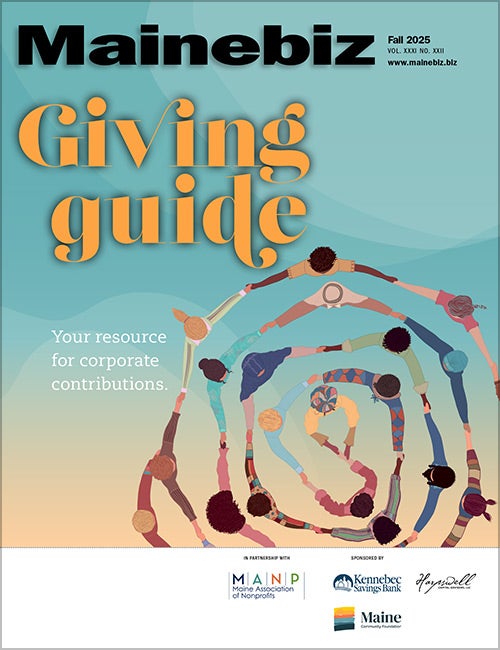
Processing Your Payment
Please do not leave this page until complete. This can take a few moments.
- News
-
Editions
View Digital Editions
Biweekly Issues
- November 03, 2025
- October 20, 2025
- October 6, 2025
- September 22, 2025
- September 8, 2025
- August 25, 2025
- + More
Special Editions
- Lists
- Viewpoints
- Our Events
- Calendar
- Biz Marketplace
Maine Coast Heritage Trust launches far-reaching $125M fundraising campaign
 Courtesy / Maine Coast Heritage Trust
In partnership with Brunswick-Topsham Land Trust, MCHT is working to conserve Woodward Point in Brunswick, one of the last, undeveloped large tracts of coastal land in southern Maine, and open it to the public as a preserve. It's a signature project in MCHT's campaign to raise $125 million by the end of 2019 to address challenges facing Maine's coast.
Courtesy / Maine Coast Heritage Trust
In partnership with Brunswick-Topsham Land Trust, MCHT is working to conserve Woodward Point in Brunswick, one of the last, undeveloped large tracts of coastal land in southern Maine, and open it to the public as a preserve. It's a signature project in MCHT's campaign to raise $125 million by the end of 2019 to address challenges facing Maine's coast.
Maine Coast Heritage Trust has raised $90 million toward a campaign goal of $125 million — part of an ambitious plan to acquire more land for public access, educational use and conservation.
The Topsham-based nonprofit said it secured $90 million in gifts of land, cash and pledges through the quiet phase of its campaign, as well as a recent $10 million matching gift, yet to be donated, toward the public fundraising part of the campaign.
It hopes to have the $125 million raised by the end of 2019.
Tim Glidden, president of the organization, made the campaign public at an event at the L.L.Bean Paddling Center in Freeport, launching the public phase to raise the remaining $25 million. Speaking with Mainebiz before the announcement, Glidden said the campaign’s quiet phase kicked off in 2014.
“Since then, it’s been building momentum,” Glidden said. “We wanted to go to the public with confidence that the goals we were setting for conservation and for community well-being in Maine can actually be achieved. So we wanted to be at the 70% level before we asked everyone to chip in.”
It will earmark $65 million for land acquisition and creation of public access and environmental protection programs; $42 million for stewardship; and $18 million for connecting people to the land through education, policy advocacy and other types of programs.
“This is not about locking up land,” said Glidden. “It’s about making land available to the public along with environmental and ecological conservation.”
During the quiet phase, he said, MCHT completed about 110 projects along the coast.
“But we’re also building our capacity, particularly through stewardship, and our ability to manage and care for these lands in perpetuity and to make them available for the people of Maine forever,” he said. “We want to come out of the campaign feeling confident that, for every piece of land that Maine Coast Heritage Trust has conserved since 1970, we have the resources to take care of these lands.”
'A long track record in Maine'
Since 1970, Maine Coast Heritage Trust has helped conserve more than 150,000 acres in Maine, from the Isles of Shoals to Cobscook Bay, including more than 300 entire coastal islands.
“We have a long track record in Maine,” said Glidden. “What we’re seeing now is that Maine as a whole, and the coast in particular, is at a critical juncture. There are substantial threats to the quality of the coast and to the communities along it, that we think will challenge the environmental quality and economic viability of coastal communities and of the coast itself.”
Challenges include:
- Commercial and recreational public water access points to the Maine coast are near historic lows (1% of the shoreline) and continue to be closed off.
- Climate change is expected to negatively impact 75% of Maine’s native plants and animals, with coastal species among the most vulnerable, unless action is taken to prepare for sea level rise and increased temperatures.
- As temperatures rise on the Eastern seaboard, Maine’s relatively cooler climate becomes increasingly attractive, especially to baby boomers who are retiring at a rate of 10,000 per day.
“When you roll all three factors together, we think this is point to act,” Glidden said. “So this campaign is designed to provide our piece of that response. We’ll look to create places along the coast for people to go, that includes access and recreation, and places that will enhance the well-being of local communities.”
MCHT has a long record of working with partners that include the land trust community, towns along the coast, and other groups, Glidden said.
“This campaign will help strengthen these partnerships,” he said.
Philanthropist donates $10 million matching gift

Glidden said gifts of all sizes are welcome. The $10 million matching gift comes from the family of philanthropist Robert Bass, who has a summer home on Mount Desert Island, said Glidden.
Coastal access is integral to Maine’s economic sustainability for industries like the commercial fisheries and tourism, said Glidden.
“We want to make sure people can make a living along the coast,” he said. “Maine has always had an economy with a strong grounding in the natural resources, and we think that, by caring for those natural resources, that’s a significant contribution to Maine’s economic future.”
The history of land conservation started with people who wanted to conserve their land, said Glidden.
“But what happens now, and how Maine Coast Heritage Trust does it, is we carefully and strategically identify lands that warrant conservation, that have the most community and ecological benefit. Then we go to those landowners and talk with them. It’s entirely on a willing-buyer and willing-seller basis,” Glidden said.
In some communities, he added, “we’ll talk with local clammers to say, ‘Okay, where are the most important access points for you that are not public land and not conserved? Are any of those at risk?’ They’ll frequently know and we don’t. We take that guidance and reach out to landowners. It’s a very thoughtful, planned process that we look to accomplish, and we attempt to listen to what the needs of the community are.”
In other cases, a town or organization will contact MCHT.
“We just completed a project in Lubec, where the town reached out to us to help them acquire a piece of land they’d like to develop as a safe harbor for their fishermen,” he said.
According to the release, MCHT owns and manages more than 120 preserves and maintains more than 80 miles of trail. The lands are free and open to the public and require ongoing maintenance and improvements. The campaign is expanding and improving trails, opening more campsites, improving preserve signage and parking, making it easier for all to connect with Maine’s incredible coastal lands and waters.
Among dozens of conservation projects underway or completed during the quiet phase, in Brunswick, MCHT is partnering with the Brunswick Topsham Land Trust to conserve Woodward Point, one of the last large undeveloped coastal parcels remaining in southern Maine, to create an expansive new coastal preserve in a quickly developing part of the coast with limited public access.
Some examples:
- In Milbridge, MCHT is teaming with a local nonprofit to protect village greenspace and create pick-your-own vegetable gardens.
- In Owls Head, MCHT and the town are working together to create a waterfront park and hand-carry boat launch site, close to newly conserved Monroe Island.
- In Lubec, MCHT worked with the town to jump-start local efforts to create a safe harbor for commercial fishermen and recreational boaters.
- In Penobscot, MCHT recently facilitated a town-initiated effort to install natural fish passageways to boost the alewife populations — a traditional economic driver in the region.
In response to rising sea level in Maine, MCHT has mobilized a coastwide effort, the Marshes for Tomorrow Initiative, to protect salt marshes as natural air and water filters, protection from storm surge and nurseries for marine organisms.
Mainebiz web partners

The Giving Guide
The Giving Guide helps nonprofits have the opportunity to showcase and differentiate their organizations so that businesses better understand how they can contribute to a nonprofit’s mission and work.
Learn More
Work for ME
Work for ME is a workforce development tool to help Maine’s employers target Maine’s emerging workforce. Work for ME highlights each industry, its impact on Maine’s economy, the jobs available to entry-level workers, the training and education needed to get a career started.
Learn More
Groundbreaking Maine
Whether you’re a developer, financer, architect, or industry enthusiast, Groundbreaking Maine is crafted to be your go-to source for valuable insights in Maine’s real estate and construction community.
Learn more-
The Giving Guide
The Giving Guide helps nonprofits have the opportunity to showcase and differentiate their organizations so that businesses better understand how they can contribute to a nonprofit’s mission and work.
-
Work for ME
Work for ME is a workforce development tool to help Maine’s employers target Maine’s emerging workforce. Work for ME highlights each industry, its impact on Maine’s economy, the jobs available to entry-level workers, the training and education needed to get a career started.
-
Groundbreaking Maine
Whether you’re a developer, financer, architect, or industry enthusiast, Groundbreaking Maine is crafted to be your go-to source for valuable insights in Maine’s real estate and construction community.
ABOUT
NEW ENGLAND BUSINESS MEDIA SITES
No articles left
Get access now
In order to use this feature, we need some information from you. You can also login or register for a free account.
By clicking submit you are agreeing to our cookie usage and Privacy Policy
Already have an account? Login
Already have an account? Login
Want to create an account? Register
Get access now
In order to use this feature, we need some information from you. You can also login or register for a free account.
By clicking submit you are agreeing to our cookie usage and Privacy Policy
Already have an account? Login
Already have an account? Login
Want to create an account? Register










Comments